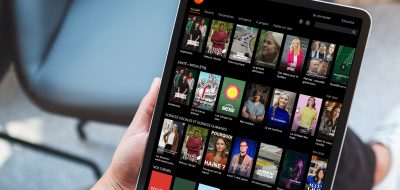The coronavirus pandemic has led to a move towards the active use of live streaming not only in the entertainment field, but also in business settings. On the other hand, because there is pressure to “get it right first time” with live streaming, the tension on the part of the operators is extremely high. I would like to consider some of the causes of this tension and think about countermeasures.
## Live streaming has become a major measure that influences corporate activities
Since the pandemic caused by the new coronavirus, corporate activities have been forced to change, and this has brought about changes in communication between companies and customers. On the other hand, the marketing and sales departments of companies still have the same responsibility to continue to deliver the results they promised on a quarterly or annual basis. They have to be actively involved in the decision-making process of potential customers within a tight schedule, but the way they communicate with customers has completely changed. Against this background, videos have come to play a complementary role in communication.
For this reason, videos have moved on from simply being used to decorate web pages and apps, and now need to be used with a purpose and managed as a tool to contribute to sales and marketing processes. As we search for appropriate communication and management methods that make use of videos, there is also a growing focus on “live streaming”, and more and more companies are getting involved in live streaming.

However, live streaming differs from VOD (Video On Demand, a service that allows viewers to watch videos when they want to) in that the motivation of the viewer is completely different.
In the case of VOD viewers, there is a strong incentive to choose which content to watch. It is up to the viewer to decide which content to watch and when to watch it, from among the multiple options available.
On the other hand, live streaming is an event that brings people together at a specific time and date. In other words, it is a way of delivering a message that has been prepared with a specific purpose in mind to viewers at a specific time.
From the above, it can be seen that live broadcasts can be an important measure that can affect the KPIs/KGI of corporate activities. In other words, if an accident occurs during a live broadcast, it can have an impact on the sales process and may also affect the results of corporate activities. Furthermore, it is possible that the expectations of viewers towards the brand will be replaced by disappointment, and the long-term impact of damage to brand value cannot be ignored.

## The major risk of live streaming is that the operator has no control over it
So, what kind of accidents can happen with live streaming? Ultimately, any event that negatively affects the viewing experience can be called an accident. This is roughly called “playback failure”. For example, the following can also be listed as part of playback failure.
### Playback failure
– The page HTML or player does not display
– Playback cannot be started
– The playback situation is not pleasant
– The page HTML or player does not display
Firstly, the reason why the page or player does not display is because the page URL is incorrect, or the pointer to the player that should be loaded or the live video linked to it is incorrect. In particular, if the live broadcast is personalized, sufficient consideration is required.
However, by testing all distribution patterns in advance during rehearsals, you can avoid any problems as long as there are no technical changes before the actual event. It is impossible to gain peace of mind just by thinking “it should work”, which is a feature of the software. You can avoid problems by making sure it is working in front of you.

– Unable to start playback, playback quality is not good
There are various technical factors that can cause problems with starting playback or poor playback quality, but we have listed the most common ones. We have also divided these into those that can be controlled by the live operator and those that cannot.
### [Things that can be controlled]
– Configuration errors in the distribution service
– Camera equipment failure or configuration errors
– Poor internet quality between the studio and distribution service
In particular, it is necessary to have correct knowledge about “decrease in internet quality between the studio and the distribution service”. If the internet quality of the so-called upstream or input stream deteriorates, it will have a direct impact on the playback quality. Setting an SLA for the uplink line from the studio to the distribution platform is not very realistic from the perspective of cost and frequency of use. Therefore, it is usually operated with two or more lines for redundancy. However, if you use the same telecommunications carrier or the operating region or network segment of the IaaS/PaaS/SaaS where the software encoder is running is the same, you need to understand that this will be useless in the event of a wide-area failure.

However, the above-mentioned things that can be controlled can be managed by evaluating the probability of failure through advance rehearsals and measures such as making equipment redundant.
### [Things that cannot be controlled (risks)]
#### Viewer-side issues
– Viewer terminals do not meet the distribution standards
– Viewer terminals have extremely low processing power
– There is a problem with the ISP or carrier that the viewer is subscribed to
– The viewer’s geographical location and the CDN
#### Bottlenecks inherent in the distribution service system
Those things that cannot be controlled cannot be solved, no matter how carefully the operator tries to respond. In addition, there are probably more factors than the operator can think of alone. However, it is clear that these factors have a significant impact on the success of a live event. In other words, those things that cannot be controlled are considered to be a risk.
Among the things that cannot be controlled, the impact of the “CDN (Content Delivery Network)” is particularly large. The number of simultaneous connections increases rapidly at large-scale live events, and the amount of data also increases depending on the quality of the video. Even if you prepare the equivalent CDN bandwidth by adding up the bandwidth as in capacity planning, it will probably fail. This is because it does not take into account the actual viewing conditions of the audience, it does not evaluate the bottlenecks in the network bandwidth that the CDN provider may be sharing, and it cannot manage the degradation of delivery quality due to increased latency caused by system costs such as CDN switching.

What you need to be aware of is the latency of your viewers. You need to be aware of the performance of each ISP and each CDN edge server group, and you need to be concerned about whether the quality of the viewing experience is deteriorating for specific user segments. For media, it is also essential to have a system in place to monitor “how many concurrent connections there are”, “whether the ads are being properly inserted”, and “whether any problems are occurring”. The role of the network operations center is to detect any signs that the viewing experience may be affected, and to alert the relevant parties to take action to prevent the phenomenon from actually occurring.
Make sure that the distribution platform you sign up with has a network operations center that can monitor these things, and that you have a contract system in place that will provide you with support.
Another thing you can do is to alert your viewers in advance by holding a small-scale live event or preparing a sample viewing page.
The next issue you need to consider is identifying the bottlenecks inherent in the distribution system. Check whether the distribution platform vendor has a track record of distributing content of a similar scale, and whether they can conduct a load test in advance. There are cases where the communication between subsystems is delayed and the entire distribution fails due to some kind of restriction triggered by the IaaS used by the distribution platform vendor. There are also cases where you encounter rare restrictions that have not been disclosed by the IaaS vendor.
## When doing live streaming, it is also important to “involve all the relevant people”
In order to prepare for various risks in order to ensure the success of live streaming, it is necessary to involve all the relevant people. And it is essential to correctly understand the work dependencies of these relevant people.
For example, the viewing page involves a variety of people, including those who design the page, those who code it, those who create the player, and those who add the function to track users of the page. It is important to understand how these tasks are related and who is responsible for what. This is because, in the event of a correction, you will be able to understand the impact of the correction and coordinate smoothly with the relevant companies that will be affected.
It is also a good idea to practice and formalize in advance how you will respond if you find any signs of problems that could occur during rehearsals. Doing so will also help to give everyone involved a sense of security.

If a problem occurs during a live broadcast, you will need to respond immediately. In case something happens on the day of the broadcast, you should check in advance who you should contact and consult with, and who the decision-makers are. It is important to have a contact system in place to ensure peace of mind. Even if an expert joins only on the day of the broadcast, it will be extremely difficult to respond to any problems that arise on the day if that person does not understand the background, circumstances, and the roles of the relevant departments. To avoid this, it is necessary to involve all the people involved in the production from the preparation stage.
This kind of knowledge is accumulated by the operator as know-how for live operations that is not often made public. This accumulation allows live operations to become more sophisticated, so the operator can focus on developing more challenging content. As a result, it can be said that this is a very important factor because it ensures differentiation from other companies.
## Why Brightcove is chosen
We are proud to say that the main reason why so many customers choose Brightcove for live streaming is our “overwhelming track record”.
We have worked on a wide range of live streaming projects, from small-scale live streaming with a few hundred viewers to live streaming of sports events with hundreds of thousands of viewers, and live streaming of global events with millions of viewers. We can provide live streaming that is stable and secure at any scale because we have accumulated know-how through our past achievements.
We also provide appropriate consulting services from the preparation and rehearsal stages of live streaming, such as proposing the optimal platform settings based on the type of audience, the network bandwidth to be used, and the type of content to be streamed. The reason we are supported by customers around the world is not only because we provide platforms, but also because we have the technology to customize them to meet the needs of our customers.




